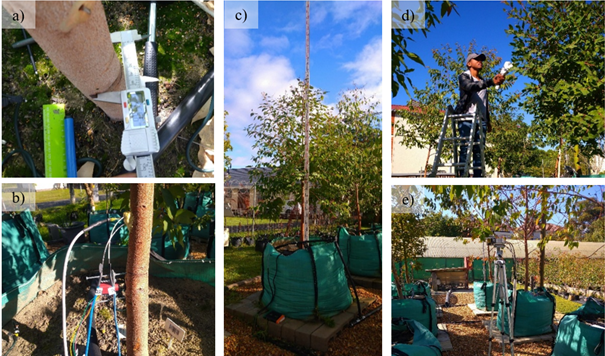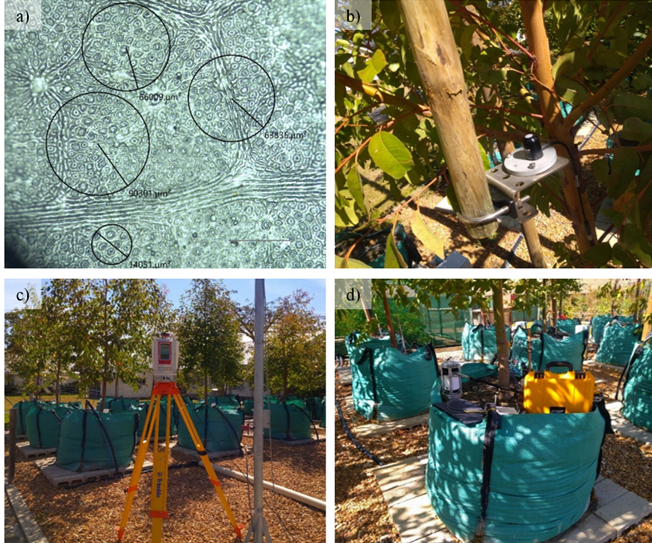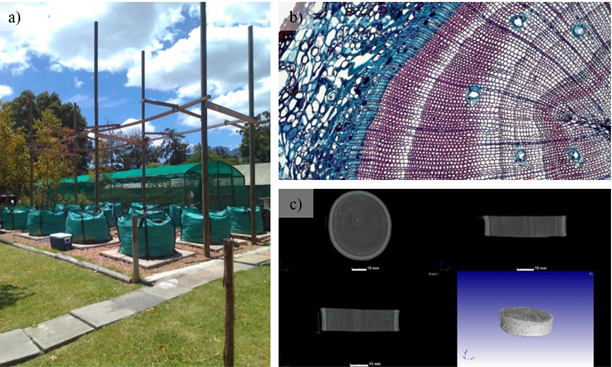
The Hans Merensky Chair in Measuring and Modelling Eucalypt Growth & Wood Formation
Understanding growth in the world's most widely planted hardwoods
The EucXylo Phenomenological Trial: the end of our flagship experiment
Post authored by Ph.D. candidate Mpilo Khumalo
Field data collection for the EucXylo Phenomenological trial, which has been the flagship for EucXylo during Phase 1 of the project, has come to an end. We have reached many incredible milestones with this study and the analysis of collected data is ongoing. The anticipated outcomes from the trial will include high-quality research papers published in high-impact journals, along with Mpilo Khumalo’s PhD dissertation.
The trial started in October 2020 with three trees of Eucalyptus grandis, Eucalyptus grandis x nitens, Eucalyptus grandis x urophylla, and Eucalyptus urophylla being planted in 1000 l bags of soil (Figure 1).
 Figure 1. Establishment of the phenomenological trial in 2020.
Figure 1. Establishment of the phenomenological trial in 2020.
The four varieties were instrumented with various equipment to intensively monitor their eco-physiological responses (Figure 2), while changes in environmental factors were continuously measured at high resolution (Figure 3).
 Figure 2. Several tree eco-physiological processes were measured during the trial. This included: (a) diameter and bark thickness with digital calipers, (b) stem radial change and sap flow using dendrometers and an HPV system, respectively, (c) height was measured with an extendable ruler, (d) stomatal conductance and fluorescence using a LI-600F porometer/fluorometer, and (e) photosynthesis using the Li-6400XT system.
Figure 2. Several tree eco-physiological processes were measured during the trial. This included: (a) diameter and bark thickness with digital calipers, (b) stem radial change and sap flow using dendrometers and an HPV system, respectively, (c) height was measured with an extendable ruler, (d) stomatal conductance and fluorescence using a LI-600F porometer/fluorometer, and (e) photosynthesis using the Li-6400XT system.
 Figure 3. (a) A Climavue50 automated weather station was used to monitor changes in environmental factors and (b) Sentek drill and drop probes were used to measure soil temperature and moisture content at every 10 cm.
Figure 3. (a) A Climavue50 automated weather station was used to monitor changes in environmental factors and (b) Sentek drill and drop probes were used to measure soil temperature and moisture content at every 10 cm.
In addition to the above mentioned eco-physiological parameters, we also measured the trees’ stomatal properties, changes in canopy architecture and canopy light interception. Additionally, the respiration of the soil was measured to better understand the CO2 dynamics during this trial (Figure 4).
 Figure 4. (a) Nail polish imprints and microscopy were used to elucidate stomatal properties of each variety, (b) interception of solar radiation by leaves and canopies was monitored with pyranometers, (c) the terrestrial lidar scanner was used to obtain a 3D perspective to analyse canopy architectural changes, and (d) soil respiration was measured with the Li-8100A system.
Figure 4. (a) Nail polish imprints and microscopy were used to elucidate stomatal properties of each variety, (b) interception of solar radiation by leaves and canopies was monitored with pyranometers, (c) the terrestrial lidar scanner was used to obtain a 3D perspective to analyse canopy architectural changes, and (d) soil respiration was measured with the Li-8100A system.
Cognisant of not being able to see much difference between the varieties during times where there is little stress, we also simulated a drought by switching off the irrigation during a dry month (Figure 5). During this time, we continued measuring all of the parameters and observed how the trees responded to the drought.
 Figure 5. The Eucalyptus trees (a) before and (b) after a month-long drought.
Figure 5. The Eucalyptus trees (a) before and (b) after a month-long drought.
After almost two years of watching the trees closely, it was time to terminate the trial (Figure 6) to obtain the biomass of the trees. The last step is to now elucidate the wood anatomy of the four varieties with microscopy and the X-ray micro-CT scanner to link functional differences to observed outcomes.
 Figure 6. (a) Images showing the empty trial site, (b) how the wood anatomy is anticipated to look and (c) an example of the information obtained with the X-ray micro-CT scanner.
Figure 6. (a) Images showing the empty trial site, (b) how the wood anatomy is anticipated to look and (c) an example of the information obtained with the X-ray micro-CT scanner.
Although this is the end of an era for Phase 1 of the EucXylo Phentrial, we’re looking forward to seeing how the wood properties and physiology of the different varieties responded to the environmental factors!